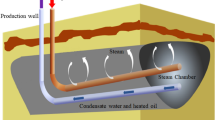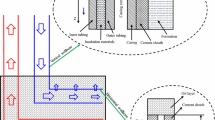Abstract
Steam channeling is one of the main barriers for EOR after steam flooding. In order to enhance the oil recovery in steam flooded reservoirs, steam channel volumes should be precisely known. In this paper, a set of methods has been established in order to study steam channeling quantitatively by using dynamic data. Firstly, steam channeling wells are identified through curves of watercut and temperature. Then, considering the hysteresis phenomenon, channeling relations are identified with the correlation coefficients between injection wells and production wells under different conditions. Lastly, an analytic model, in which steam condensation, pressure and temperature are considered, is established to calculate the steam channel volumes. A production well named L31615 in some block in Henan Oilfield in China is systematically analyzed by using the method established. The whole block is further analyzed, and the distribution map of steam channels and the steam channel volumes are obtained. The results show that steam channeling does not only occur inside a well group, but also sometimes occurs between wells in different well groups. The calculation of the steam channel volumes provides a theoretical basis for bringing a remedial action like plugging into operation.
Similar content being viewed by others
References
Chang W, Zhang Y. New Progress of Heavy Oil Thermal Recovery Technique (in Chinese). 2nd ed. Beijing: Petroleum Industry Press, 1999. 7–9
Najeh A, Mahmoud R P, Hadi J. A new semi-analytical modeling of steam-assisted gravity drainage in heavy oil reservoirs. J Petrol Sci Eng, 2009, 69(3–4): 261–270
Santos M D, Neto A D, Mata W, et al. New antenna modelling using wavelets for heavy oil thermal recovering methods. J Petrol Sci Eng, 2011, 76(1–2): 63–75
Bian X B, Zhang S C, Zhang J C, et al. A new method to optimize the fracture geometry of a frac-packed well in unconsolidated sandstone heavy oil reservoirs. Sci China Tech Sci, 2012, 55(6): 1725–1731
Hu C Z. Technique of Heavy Oil Thermal Recovery (in Chinese). 2nd ed. Beijing: Petroleum Industry Press, 1998. 10–15
Yousef A A, Lake L W, Jensen J L, et al. Analysis and interpretation of interwell connectivity from production and injection rate fluctuations using a capacitance model. SPE 99998, 2006
Dinh A, Tiab D. Inferring interwell connectivity from well bottomhole pressure fluctuations in waterfloods. SPE Reserv Eval Eng, 2008, 11(5): 874–881
Lzgec O, Kabir C S. Establishing injector/producer connectivity before breakthrough during fluid injection. SPE 121203, 2009
Dai C L, Ji W J, Jiang H Q, et al. Performance experiment on thermal thixotropic system for deep channeling plugging in steam huff and puff wells (in Chinese). J China Univ Petrol, 2010, 34(4): 167–171
Cao Y B, Liu D Q, Tang P Z, et al. Improving multiple steam stimulation effects with foam fluids in the Cao-20 Block (in Chinese). Petrol Drill Tech, 2006, 34(2): 1–4
Niu S F. Research and application of channeling plugging technique by using foam with gasifying nitrogen-carbon by steam (in Chinese). Petrol Geol Recov Effici, 2005, 12(1): 78–80
Wu X D, Zhang Y F, Liu Y H. Steam stimulated wells gas injection orthogonal optimization design (in Chinese). Petrol Drill Tech, 2007, 35(3): 1–4
Gao Y R, Liu S Q, Shen D H, et al. Study on N_2 and solvent assisted steam stimulation in a super-heavy oil reservoir (in Chinese). Petrol Explor Develop, 2003, 30(2): 73–75
Zhang H L, Liu H Q, Wang H, et al. Optimization design of profile control parameters for steam stimulation wells (in Chinese). Acta Petrolei Sin, 2007, 28(2): 105–108
Zhang D J, Guo H M, Dai J C, et al. Study on steam channeling in steam flooding of heavy oil reservoir (in Chinese). China Measur Tech, 2004, 30(3): 45–50
Dong Y Q, Wang Z M. Some notes about correiation coefficient ρ (in Chinese). Coll Math, 2008, 24(2): 182–186
Albertoni A, Lake L W. Inferring inferring interwell connectivity only from well-rate fluctuations in waterfloods. SPE Reserv Eval Eng, 2003, 6(1): 6–16
Zhang R. Thermal Recovery Technology in Heavy Oil Reservoir (in Chinese). 1st ed. Beijing: Petroleum Industry Press, 1999. 414–418
Li C L, Cheng L S. A method for calculating heating radius in steam stimulation of viscous oil reservoir (in Chinese). Xinjiang Petrol Geol, 1998, 19(3): 247–249
Author information
Authors and Affiliations
Corresponding author
Rights and permissions
About this article
Cite this article
Zheng, Q., Liu, H., Li, F. et al. Quantitative description of steam channels after steam flooding. Sci. China Technol. Sci. 56, 1164–1168 (2013). https://doi.org/10.1007/s11431-013-5203-8
Received:
Accepted:
Published:
Issue Date:
DOI: https://doi.org/10.1007/s11431-013-5203-8




